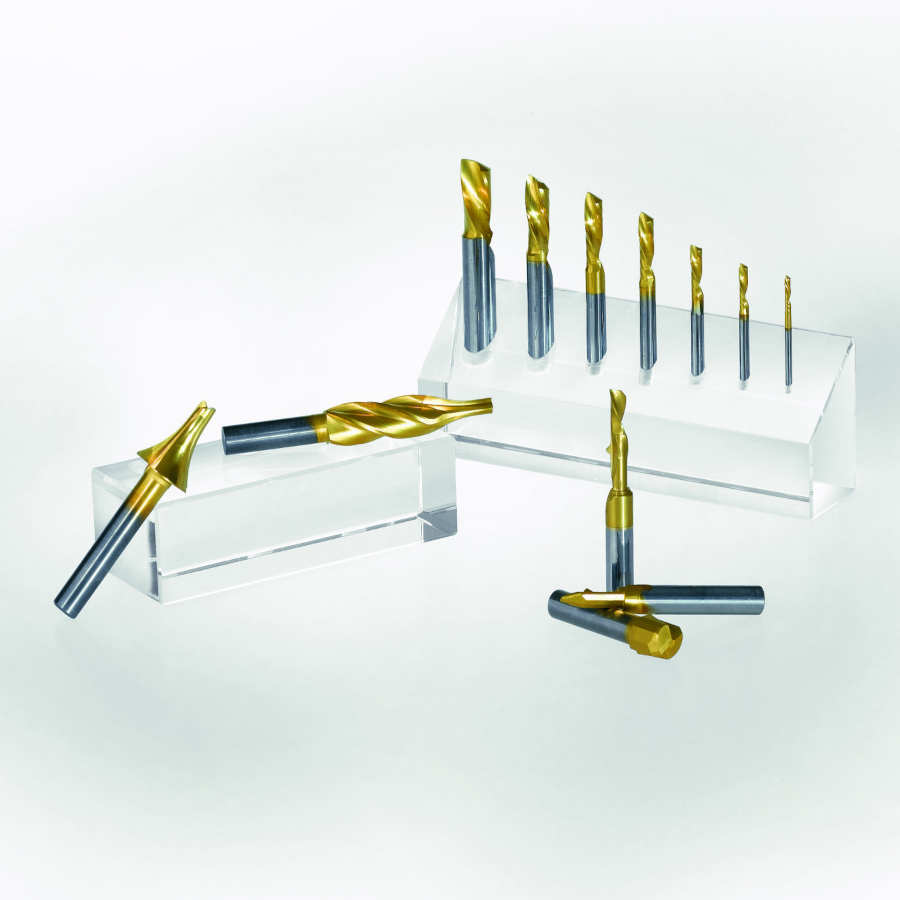
Tool recoating: which is the most suitable?
https://www.tommasin.com/wp-content/uploads/2020/10/composizione-oro1-scaled.jpg
Today, increasingly highly performance tools are required, capable of withstanding consistent stock removal or high feed rates. For this reason, we at TOMMASIN choose only the best raw material for tool recoating, based on:
- The workpiece’s material.
- The type and shape of the component.
- The machining conditions.
- The desired surface finish level for each operation.
Tool recoating phases
The main tool recoating stages are:
- Choosing the right surface finish for the tool, together with the best coating.
- Eliminating any grinding irregularities on the tool’s cutting edge.
- Optimising the cutting edge (to allow the best coating thickness to be chosen).
- Post-coating treatment to eliminate macro-particles.
Coating material characteristics
Tool coating materials have different hardness, toughness and wear resistance combinations, but, in general, they should be:
- Hard enough to withstand flank wear and plastic deformation.
- Tough enough to withstand macro-breaks.
- Non-reactive to the workpiece material.
- Chemically stable to withstand oxidation and diffusion.
- Resistant to sudden thermal variations.
Contact us, to carry out the coating of your tool
Types of coatings
The most common types of coating are:
Coated carbide
Coated carbide combines its substrate with a coating. Its advantages are:
- Wear resistance
- Toughness
- The possibility of being modelled into complex shapes.
As a result of these characteristics, it is used in a wide range of tools and applications.
Coating – CVD
CVD stands for chemical vapour deposition.
CVD coatings are characterised by:
- High wear resistance
- Excellent carbide adhesion.
More specifically:
- Titanium carbonitride CVD coatings have good abrasion wear resistance, resulting in reduced wear to the flank.
- Alumina CVD coatings have a good resistance to crater wear and can be used as a thermal barrier to increase plastic deformation resistance.
- Titanium nitride CVD coatings offer the best wear resistance and are also used to detect wear.
CVD coatings are mainly used for applications where wear resistance is a key factor, such as general turning, steel boring, turning and milling stainless steels.
Coating – PVD
PVD coatings are coatings obtained by physical vapour deposition. The process is based on evaporation of a metal that reacts with another element, to form a hard coating on the surface of the tool.
Its advantages are:
- Wear resistance.
- Increased toughness of the cutting edge.
- Resistance to the formation of comb cracks.
In particular, PVD coatings comprising:
- Titanium nitride are versatile and have a golden colour.
- Carbonitride have a greater flank wear resistance.
- Aluminium nitride and titanium have high hardness and oxidation resistance.
- Oxides have high chemical inertia and crater wear resistance.
PVD coatings are used for tough and sharp cutting edges and for materials with a tendency to stick. These applications are typical of end mills, solid drills and most grades for grooving, threading and milling.
Carbide
Carbide is a powdered material consisting essentially of tungsten carbide particles and a binder rich in metal cobalt.
The main features of a carbide coating are:
- Controlled toughness.
- High plastic deformation resistance.
- Heat resistance.
In particular, there are the following types of carbide grain:
- Medium-coarse, with a high heat resistance and toughness.
- Fine or submicronic, which make the sharp cutting edge more robust. Another advantage is the exceptional resistance to cyclic thermal and mechanical loads.
Polycrystalline diamond
Polycrystalline diamond or PCD is a composite material comprising diamond particles sintered with a metal binder.
It is characterised by:
- Strong abrasion resistance.
- Good wear resistance.
- Not chemically-unstable at high temperatures.
PCD is used with non-ferrous materials, such as:
- Aluminium with a high silicone content.
- Metal matrix composite materials.
- Carbon fibre-reinforced plastic.
- Titanium super finishing.


